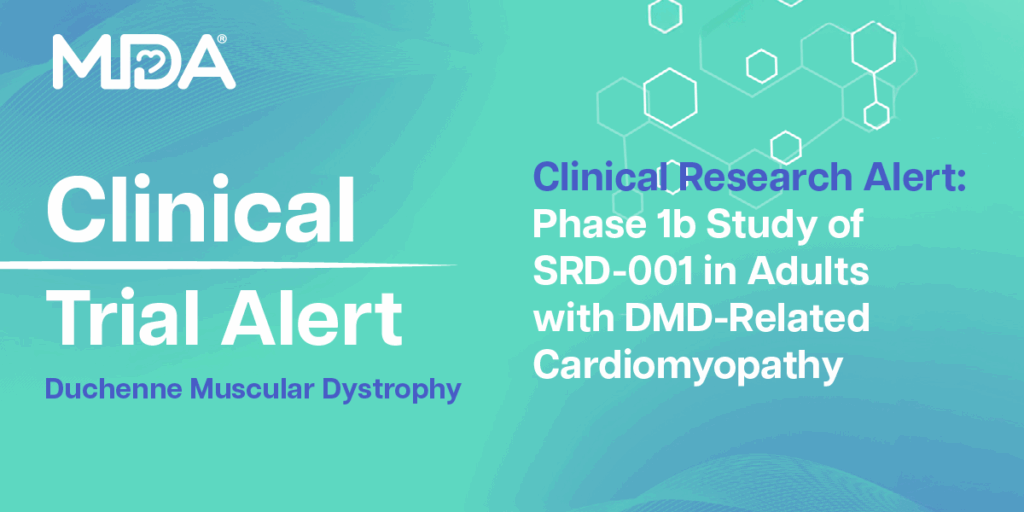
Simply Stated: Updates in Neuropathy Ataxia and Retinitis Pigmentosa (NARP) Syndrome
By Sujatha Gurunathan | Thursday, October 30, 2025
5 Second Summary
“Simply Stated” is a Quest column designed to explain some terms and basic facts about neuromuscular diseases.
Find more at Mdaquest.org/tag/simply-stated
Neuropathy ataxia and retinitis pigmentosa (NARP) syndrome is a rare, maternally-inherited condition caused by mutations in mitochondrial DNA, affecting the energy-producing structures within cells. The condition typically begins in childhood or early adulthood and presents with a wide range of symptoms. These may include learning difficulties, muscle weakness (particularly around the eyes), uncoordinated movements (ataxia), and sensory changes in the hands and feet. Symptoms and disease severity can vary greatly between affected individuals. It is estimated that NARP affects about 1 to 9 people per 100,000.
Symptoms of NARP syndrome
Many people with NARP syndrome begin experiencing symptoms in childhood or early adulthood. The syndrome is progressive, meaning it worsens over time, and can present with a diverse range of symptoms, which may include, but are not limited to:
- Developmental delays
- Pain, tingling, or numbness in the limbs due to sensory neuropathy
- Balance and coordination problems (ataxia)
- Vision loss due to degeneration of the retina (pigmentary retinopathy)
- Muscle weakness, including potential involvement of cardiac or respiratory muscles
- Recurrent seizures (epilepsy)
- Learning difficulties or, in some cases, cognitive decline
NARP syndrome represents a spectrum of disease. In some cases, the prognosis for NARP syndrome is poor, leading to functional disabilities such as blindness, deafness, and wheelchair dependence in affected individuals over time.
For more information about the signs, genetic causes, and clinical management of NARP syndrome, see the overview published by the American Academy of Ophthalmology.
Cause of NARP
NARP belongs to a class of disorders known as mitochondrial disorders. Mitochondrial disorders are caused by inherited mutations affecting the function of mitochondria, the energy-producing structures in cells. These disorders typically impact organ systems with high energy requirements, such as the brain, skeletal muscles, and heart.
Mitochondrial disorders can result from mutations in either mtDNA or nuclear DNA. In the case of NARP, the condition is most often caused by a mutation in the mitochondrial ATPase 6 (MT-ATP6) gene, typically a T to G or sometimes a T to C change at nucleotide position 8993. Since the mutation occurs in mtDNA, the disorder is inherited exclusively from the mother. The same MT-ATP6 mutations are also linked to a form of Leigh syndrome, a more severe mitochondrial disorder that often begins in infancy. Some researchers believe NARP and Leigh syndrome are part of the same disease spectrum. The severity of disease depends on heteroplasmy, the ratio of mutant to normal mtDNA in cells. People with about 50–70% mutant mtDNA usually develop NARP, while those with over 90% mutant mtDNA tend to develop Leigh syndrome.
Current management of NARP
There is currently no known cure or disease-modifying therapy for NARP syndrome. Management is supportive and tailored to each individual’s symptoms. This may include treatment for complications of NARP such as high levels of lactic acid in the blood (lactic acidosis), seizures, uncontrolled movements (dystonia), and heart problems. Some patients may benefit from vitamins or dietary changes aimed at supporting mitochondrial function or reducing cell damage due to oxidative stress.
Given the variability of symptoms, care often involves a team of specialists, including neurologists, ophthalmologists, cardiologists, geneticists, and others, as well as regular monitoring and psychological support. Certain medications (e.g., sodium valproate, barbiturates, dichloroacetate, and anesthetics) can worsen symptoms and are generally avoided.
Observational studies
While the standard of care is still symptom management, research advances offer hope for people living with NARP syndrome. Patient registries and observational studies, in particular, are being established to help collect and analyze data from people with NARP in order to improve understanding of this syndrome and inform future therapeutic development. Notable efforts include:
Global Registry and Natural History Study for Mitochondrial Disorders (LMU Klinikum) – A patient registry and natural history study that is recruiting participants with mitochondrial disease in Germany. This is a longitudinal study that collects clinical data over time.
North American Mitochondrial Disease Consortium Patient Registry and Biorepository (NAMDC) (Columbia University) – A patient registry and tissue biorepository that is recruiting participants with mitochondrial disease at sites throughout the United States. This effort collects both clinical information and biological samples.
Mitochondrial Disease Sequence Data Resource Consortium (MSeqDR) – An international database that primarily collects genetic and clinical information from people with mitochondrial disease.
Rare Disease Patient Registry & Natural History Study – Coordination of Rare Diseases at Sanford (Sanford Health) – A patient registry that is recruiting participants with rare diseases, including mitochondrial disorders, at sites in South Dakota and Sydney, Australia.
Tissue Sample Study for Mitochondrial Disorders (Columbia University) – An observational study that is enrolling participants with mitochondrial disease by invitation in New York City. The focus of this effort is on collecting tissue samples.
UMDF Global Mitochondrial Patient Registry (United Mitochondrial Disease Foundation) – A global patient registry that collects clinical and demographic information from individuals with mitochondrial disease, including NARP.
Therapeutic efforts in NARP
Therapeutic development for NARP is still in the early stages, with no approved disease-modifying treatments available. Emerging approaches under investigation include mitochondrial-targeted antioxidants, such as EPI-743 and coenzyme Q10 analogs, which aim to improve cellular energy function and reduce oxidative stress. Nucleoside therapy, while currently used for some mtDNA depletion syndromes, has not yet been applied to NARP. In addition, gene therapy and mtDNA editing are being explored in preclinical studies as potential future strategies to address the underlying genetic defects in NARP and other mitochondrial disorders.
MDA’s work to further cutting-edge NARP research
Since its inception, MDA has invested more than $26 million in mitochondrial disease research. Through strategic investments from MDA, partner advocacy groups, and the National Institutes of Health (NIH), mitochondrial disease research is advancing, offering hope for breakthroughs and a better future for those living with conditions such as NARP syndrome.
MDA’s Resource Center provides support, guidance, and resources for patients and families, including information about neuropathy ataxia and retinitis pigmentosa (NARP) syndrome, open clinical trials, and other services. Contact the MDA Resource Center at 1-833-ASK-MDA1 or ResourceCenter@mdausa.org.
Next Steps and Useful Resources
- For more information about the signs and symptoms of Neuropathy ataxia and retinitis pigmentosa (NARP), as well an overview of diagnosis and treatment concerns, an in-depth review can be found here.
- For more information about the signs, genetic causes, and clinical management of NARP syndrome, see the overview published by the American Academy of Ophthalmology.
- MDA’s Resource Center provides support, guidance, and resources for patients and families, including information about neuropathy ataxia and retinitis pigmentosa (NARP) syndrome, open clinical trials, and other services. Contact the MDA Resource Center at 1-833-ASK-MDA1 or ResourceCenter@mdausa.org.
- Stay up to date on Quest content! Subscribe to Quest Magazine and Newsletter.
TAGS: Simply Stated
TYPE: Blog Post
Disclaimer: No content on this site should ever be used as a substitute for direct medical advice from your doctor or other qualified clinician.




